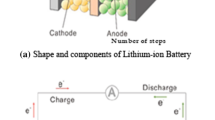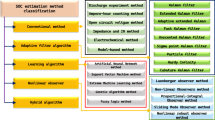Abstract
Lithium-ion batteries are becoming more popular due to their superior performance like high power density, long lifespan, broad operating range of temperatures, quick charging capabilities, and low self-discharge. The implementation of a Battery Management System (BMS) is crucial in order to guarantee the secure and optimal functioning of electric vehicle batteries. BMS monitors, controls, and maintains the health and performance of rechargeable batteries by monitoring the State of Charge (SoC), State of Health (SoH), and State of Temperature (SoT). SoC quantifies the amount of energy stored in a battery at a certain moment, and it is employed to approximate the remaining distance that may be covered. SoH describe the overall health or state of a rechargeable battery. It reveals how well a battery performs in comparison to its original state. SoT estimation keeps the battery temperature within a safe range, allowing it to reach a higher age and safety, which is critical for battery reliability. In this paper SoC, SoH, SoT estimation models for a lithium-ion battery have been developed using an improved EP-based R110-BLSTM approach. The Emperor Penguin based Residual Network-110 incorporated Bidirectional Long-Short Term Memory (EP-based R110-BLSTM) is ideal for estimating SoC, SoH, and SoT and features great accuracy, a quick estimation speed, and strong generalization capabilities. However, Extreme Learning Machine performance is heavily reliant on proper feature extraction. In order to enhance estimate performance by extracting the best features, Simulated-Annealing-based Golden Eagle optimization is utilized. Electric vehicle drive cycles are used to test the model’s resilience to temperature changes. MATLAB 2018b software is used in the execution of this research. The results demonstrate that the proposed model performs better in terms of accuracy and has lower SoC, SoH, and SoT error rates than existing models. A thorough comparison between the recommended model and existing methods is also made, further demonstrating the proposed model’s superiority.







Similar content being viewed by others
References
Bandyopadhyay S, Saha S, Maulik U, Deb K (2008) A simulated annealing-based multiobjective optimization algorithm: AMOSA. IEEE Trans Evol Comput 12(3):269–283. https://doi.org/10.1109/TEVC.2007.900837
Bockrath S, Rosskopf A, Koffel S, Waldhor S, Srivastava K, Lorentz VRH (2019) State of charge estimation using recurrent neural networks with long short-term memory for lithium-ion batteries. In: IECON proceedings (industrial electronics conference), 2019-October, pp 2507–2511. https://doi.org/10.1109/IECON.2019.8926815
Harifi S, Khalilian M, Mohammadzadeh J, Ebrahimnejad S (2019) Emperor Penguins Colony: a new metaheuristic algorithm for optimization. Evol Intell 12(2):211–226. https://doi.org/10.1007/S12065-019-00212-X/TABLES/10
Hariprasad A, Priyanka I, Sandeep R, Ravi V, Shekar O, Students UG (2020) Battery management system in electric vehicles. Int J Eng Res Technol. https://doi.org/10.17577/IJERTV9IS050458
He W, King M, Luo X, Dooner M, Li D, Wang J (2021) Technologies and economics of electric energy storages in power systems: review and perspective. Adv Appl Energy 4:100060. https://doi.org/10.1016/J.ADAPEN.2021.100060
Hussein AA (2015) Capacity fade estimation in electric vehicle Li-ion batteries using artificial neural networks. IEEE Trans Ind Appl 51(3):2321–2330. https://doi.org/10.1109/TIA.2014.2365152
Ko Y, Choi W (2021) A new SOC estimation for LFP batteries: application in a 10 Ah cell (HW 38120 L/S) as a hysteresis case study. Electronics 10(6):705. https://doi.org/10.3390/ELECTRONICS10060705
Kumar RR, Alok K (2020) Adoption of electric vehicle: a literature review and prospects for sustainability. J Clean Prod 253:119911. https://doi.org/10.1016/J.JCLEPRO.2019.119911
Leal VM, Ribeiro JS, Coelho ELD, Freitas MBJG (2023) Recycling of spent lithium-ion batteries as a sustainable solution to obtain raw materials for different applications. J Energy Chem 79:118–134. https://doi.org/10.1016/J.JECHEM.2022.08.005
Li S, Li K, **ao E, **ao E, Wong CK (2020) Joint SoC and SoH estimation for zinc-nickel single-flow batteries. IEEE Trans Ind Electron 67(10):8484–8494. https://doi.org/10.1109/TIE.2019.2949534
Lu L, Han X, Li J, Hua J, Ouyang M (2013) A review on the key issues for lithium-ion battery management in electric vehicles. J Power Sources 226:272–288. https://doi.org/10.1016/J.JPOWSOUR.2012.10.060
Mawonou KSR, Eddahech A, Godoy E, Beauvois D, Dumur D, Mensler M (2018) Li-ion battery pack SoC estimation for electric vehicles. In: Proceedings: IECON 2018—44th annual conference of the IEEE industrial electronics society, pp 4968–4973. https://doi.org/10.1109/IECON.2018.8591187
Meng J, Luo G, Gao F (2016) Lithium polymer battery state-of-charge estimation based on adaptive unscented Kalman filter and support vector machine. IEEE Trans Power Electron 31(3):2226–2238. https://doi.org/10.1109/TPEL.2015.2439578
Meng J, Ricco M, Luo G, Swierczynski M, Stroe DI, Stroe AI, Teodorescu R (2018) An overview and comparison of online implementable SOC estimation methods for lithium-ion battery. IEEE Trans Ind Appl 54(2):1583–1591. https://doi.org/10.1109/TIA.2017.2775179
Mishra S, Swain SC, Samantaray RK (2021) A review on battery management system and its application in electric vehicle. In: 10th International conference on advances in computing and communications, ICACC 2021. https://doi.org/10.1109/ICACC-202152719.2021.9708114
Mohammadi-Balani A, Dehghan Nayeri M, Azar A, Taghizadeh-Yazdi M (2021) Golden eagle optimizer: a nature-inspired metaheuristic algorithm. Comput Ind Eng 152:107050. https://doi.org/10.1016/J.CIE.2020.107050
Pandey D, Sambath Kumar K, Henderson LN, Suarez G, Vega P, Salvador HR, Roberson L, Thomas J (2022) Energized composites for electric vehicles: a dual function energy-storing supercapacitor-based carbon fiber composite for the body panels. Small. https://doi.org/10.1002/SMLL.202107053
Wang L, Wang X, Yang W (2020) Optimal design of electric vehicle battery recycling network—from the perspective of electric vehicle manufacturers. Appl Energy 275:115328. https://doi.org/10.1016/J.APENERGY.2020.115328
Wang QK, He YJ, Shen JN, Hu XS, Ma ZF (2018) State of charge-dependent polynomial equivalent circuit modeling for electrochemical impedance spectroscopy of lithium-ion batteries. IEEE Trans Power Electron 33(10):8449–8460. https://doi.org/10.1109/TPEL.2017.2780184
Wong KL, Bosello M, Tse R, Falcomer C, Rossi C, Pau G (2021) Li-Ion batteries state-of-charge estimation using deep LSTM at various battery specifications and discharge cycles. In: GoodIT 2021—proceedings of the 2021 conference on information technology for social good, pp 85–90. https://doi.org/10.1145/3462203.3475878
**ao D, Fang G, Liu S, Yuan S, Ahmed R, Habibi S, Emadi A (2020) Reduced-coupling coestimation of SOC and SOH for lithium-ion batteries based on convex optimization. IEEE Trans Power Electron 35(11):12332–12346. https://doi.org/10.1109/TPEL.2020.2984248
Yang B, Wang Y, Zhan Y (2022) Lithium battery state-of-charge estimation based on a Bayesian optimization bidirectional long short-term memory neural network. Energies 15(13):1–18
Author information
Authors and Affiliations
Contributions
PK written the manuscript and NK provided the guidance.
Corresponding author
Ethics declarations
Conflict of interest
The authors declare no conflict of interest.
Additional information
Publisher's Note
Springer Nature remains neutral with regard to jurisdictional claims in published maps and institutional affiliations.
Rights and permissions
Springer Nature or its licensor (e.g. a society or other partner) holds exclusive rights to this article under a publishing agreement with the author(s) or other rightsholder(s); author self-archiving of the accepted manuscript version of this article is solely governed by the terms of such publishing agreement and applicable law.
About this article
Cite this article
Kumari, P., Kumar, N. Hybrid optimized deep learning approach for prediction of battery state of charge, state of health and state of temperature. Electr Eng 106, 1283–1290 (2024). https://doi.org/10.1007/s00202-023-02105-w
Received:
Accepted:
Published:
Issue Date:
DOI: https://doi.org/10.1007/s00202-023-02105-w




